Trigger Point Therapy for Myofascial Pain (25 page)
Read Trigger Point Therapy for Myofascial Pain Online
Authors: L.M.T. L.Ac. Donna Finando

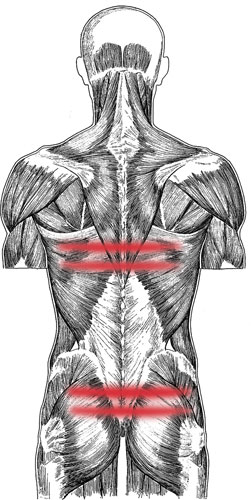
Rectus abdominis (posterior) pain pattern
Pain pattern:
Trigger points within the proximal aspect of the muscle may produce bilateral midback pain; trigger points within the distal aspect may produce horizontal low back pain as well as unilateral pain in the lower abdomen. Symptoms include heartburn, the sensation of abdominal fullness, indigestion, vomiting, and nausea; periumbilical involvement produces abdominal cramping. Lower trigger point involvement may result in dysmenorrhea.
Causative or perpetuating factors:
Acute or chronic overload strain; muscular overuse; visceral disease; abdominal surgical scars; paradoxical breathing; poor posture.
Satellite trigger points:
External oblique, internal oblique, transversus abdominis, iliocostalis thoracis, iliocostalis lumborum, longissimus thoracis, iliopsoas.
Affected organ systems:
Digestive and genitourinary systems.
Associated zones, meridians, and points:
Ventral zone; Foot Yang Ming Stomach meridian, Foot Shao Yin Kidney meridian; ST 19â30, KI 11â21.
Stretch exercise:
Cobra: Lying prone, place the hands palms down at the level of the chest. Raise the upper body, supporting it with the weight on the arms. Arch the head and neck toward the ceiling, keeping the hips, legs, and feet relaxed on the floor. Hold for a count of fifteen to twenty. Release the stretch by relaxing the arms, bending the elbows to support the upper body weight and slowly bringing the body down to the prone position.
Strengthening exercises:
- Roll downs: Begin in the seated position with the legs extended in front of you. Bend the knees, placing the soles of the feet on the floor. Inhale. Exhale, dropping the chin to the chest, rounding the lumbar spine, and slowly rolling backward toward the floor. First the lumbar spine touches the floor, then the thoracic spine, then the upper back, then the head. If need be you can control the backward movement of your weight by holding on to your legs as you roll back. Greater stress will be placed on the abdominal muscles the more slowly you roll down. Reverse the exercise to roll up.
- Abdominal crunches: Lying in the supine position bend the knees, placing the soles of the feet on the floor. Clasp the hands behind the head or cross the arms on the chest. Inhale deeply. Exhale, focusing on touching the navel to the spine, and roll up by bringing the chin to chest, raising the upper body, and lifting the scapulae off the floor. Slowly roll down to the starting position. Repeat three to five times, increasing repetitions as strength allows.
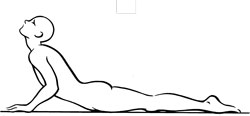
Stretch exercise: Rectus abdominis
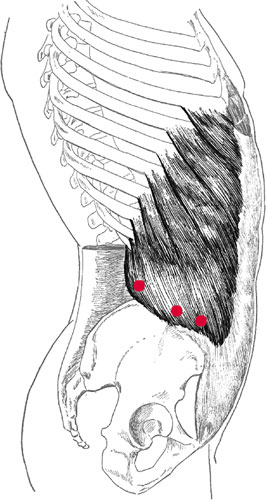
Abdominals (external oblique) and trigger points
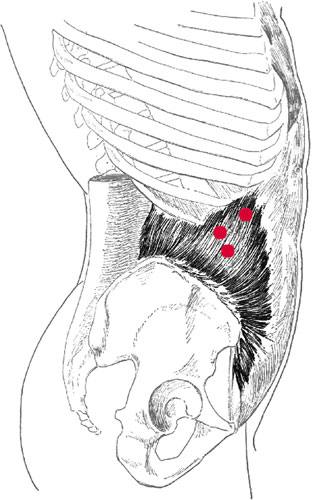
Abdominals (internal oblique) and trigger points
A
BDOMINALS
E
XTERNAL
O
BLIQUE
, I
NTERNAL
O
BLIQUE,
T
RANSVERSUS
A
BDOMINIS
Proximal attachment:
External oblique:
six lower ribs.
Internal oblique:
iliopsoas fascia adjacent to the lateral one-half of the inguinal ligament, anterior iliac crest, spinous and transverse processes of the five lumbar vertebrae via the thoracolumbar fascia, cartilages of ribs 9â12.
Transversus abdominis:
lumbar vertebrae via the thoracolumbar aponeurosis, the lower six ribs, anterior iliac crest, iliopsoas fascia adjacent to the lateral aspect of the inguinal ligament.
Distal attachment:
External oblique:
linea alba via an abdominal aponeurosis forming the anterior rectus sheath (passing superficial to rectus abdominis), anterior iliac crest, pubis.
Internal oblique:
linea alba via the abdominal aponeurosis forming the anterior rectus sheath (passing superficial to rectus abdominis).
Transversus abdominis:
linea alba via the abdominal aponeurosis forming the posterior rectus sheath (passing deep to rectus abdominis), pubis.
Action:
Compression of the abdomen.
External oblique:
rotation of the trunk to the opposite side. Lateral flexion of the trunk to the same side when acting with the homolateral internal oblique.
Internal oblique:
lateral flexion and rotation of the trunk to the same side when acting with the contralateral external oblique.
Palpation:
For general instruction on palpating the abdominal muscles, see page 143.
To locate external oblique, internal oblique, and transversus abdominis, identify the following structures:
- Ribs 7â12
- Anterior aspect of the iliac crest
- Pubic bone
- Linea alba (white line)âTendinous union of the bilateral aponeuroses of the external oblique, internal oblique, and transversus abdominis, lying deep to the skin in the midline of the torso
Palpate external oblique on the lateral aspect of the torso. Note that its fibers run obliquely down and medially. Begin palpation on the lateral aspect of the lower rib cage, placing your hands along the fiber direction of the muscle. Hand movement will move downward and medial to the iliac crest and toward the pubic bone. Palpation must be gentle enough to examine the musculature without forcing through it to the underlying viscera.
It may be difficult to distinguish external oblique from the underlying internal oblique and transversus abdominis; however, the right external oblique can be palpated when rotation to the left is resisted and vice versa. Ask the patient to rotate his right shoulder toward his left hip. Resist this motion at the shoulder while placing the palpating hand proximal to the iliac crest. External oblique can be palpated as it contracts to perform this movement.
Palpate internal oblique through the overlying external oblique on the lateral aspect of the torso. Note that its fibers run obliquely upward and lateral. Begin palpation on the lateral aspect of the lower rib cage, palpating toward the iliac crest and the inguinal ligament. It may be difficult to distinguish internal oblique from the overlying external oblique; however, the left internal oblique can be palpated when rotation to the left is resisted and vice versa. Ask the patient to rotate his right shoulder toward his left hip. Resist this motion at the shoulder while placing the palpating hand proximal to the iliac crest. Internal oblique can be palpated as it contracts to perform this movement.
Transversus abdominis is obscured to palpation due to its placement deep to external oblique and internal oblique.
Pain pattern:
External oblique:
Heartburn, epigastric pain, flank pain, groin and testicular pain when trigger points are present in both transversus abdominis and internal oblique. Visceral dysfunction represents considerable symptomology associated with trigger points in the internal oblique and transversus abdominis, making pictorial representation of pain patterns unnecessary.
Internal oblique:
Symptoms are irritability and spasm of the urinary sphincter, leading to urinary frequency, retention of urine, and groin pain.
Transversus abdominis:
Symptoms are groin and testicular pain when trigger points are present in external oblique and internal oblique.
Causative or perpetuating factors:
Acute or chronic overload strain; muscular overuse; abdominal surgical scars; visceral disease; paradoxical breathing; poor posture; sustained or vigorous twisting of the torso.
Satellite trigger points:
Each abdominal muscle may develop satellite trigger points in response to the presence of trigger points in other muscles of the group. Additional trigger points might also be found in the iliopsoas, iliocostalis thoracis, and longissimus thoracis.
Affected organ systems:
Digestive, genitourinary, and reproductive systems.
Associated zones, meridians, and points:
Ventral and lateral zones; Foot Yang Ming Stomach meridian, Foot Shao Yang Gall Bladder meridian, Foot Jue Yin Liver meridian, Foot Tai Yin Spleen meridian; SP 14, 15, and 16; LIV 13; GB 25â28.
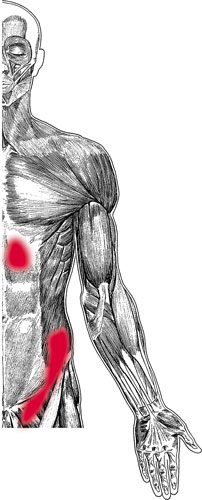
Abdominals pain pattern
Stretch exercises:
- Cobra: Lying prone, place the hands palms down at the level of the chest. Raise the upper body, supporting it with the weight on the arms. Arch the head and neck toward the ceiling, keeping the hips, legs, and feet relaxed on the floor. Release the stretch by relaxing the arms, bending the elbows to support the upper body weight, and slowly bringing the body down to the prone position.
- Stand with the back approximately 12 inches away from a wall. Twist the upper body and place both palms on the wall. Hold for a count of fifteen to twenty. Note: To stretch the right external oblique the patient must turn toward the right; to stretch the right internal oblique, the patient must turn toward the left.
Strengthening exercises:
Transverse crunches: Lying in the supine position, bend the knees and place the soles of the feet on the floor. Clasp the hands behind the head or cross the arms on the chest. Inhale deeply. Exhale, focusing on touching the navel to the spine, and roll up by bringing the chin to chest, raising the upper body, and lifting the scapulae off the floor. Twist the body, aiming the right shoulder for the left hip. Slowly roll down to the starting position. Repeat the exercise, this time aiming the left shoulder for the right hip.
